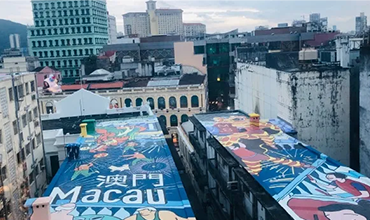

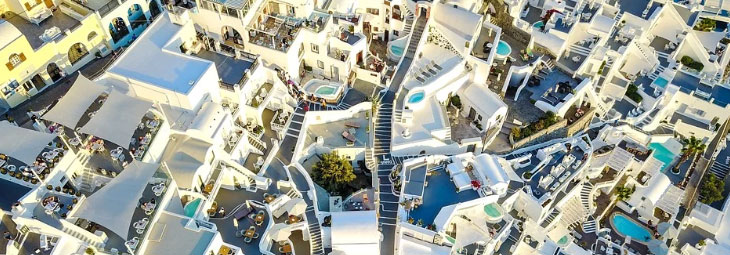
"The world is a book, and those who do not travel read only one page." Macau, a city as dazzling as a pearl, may be small in size, but it holds endless wonders and diverse charm. Now marking the 25th anniversary of its return to China, Macau often feels both familiar and mysterious in people's minds.
Today, let's explore a different side of Macau through 10 perspectives on urban planning.
1.A Small yet Beautiful City: The World's Most Densely Populated Yet Prosperous Urban Hub.
Macau, a microcity, spans a modest 33.3 square kilometers, including the 361.65 hectares of reclaimed land approved by the central government in 2009. This area is just 2.97% of Hong Kong's 1,104.38 square kilometers, making Macau truly a tiny speck on the map.
Despite its size, Macau had a total population of 683,700 in 2023, resulting in a population density of 20,400 people per square kilometer, the highest in the world. This density is 2.65 times that of Singapore and 2.95 times that of Hong Kong. On the Macau Peninsula, population density soars to 56,400 people per square kilometer, with neighborhoods like Areia Preta and Iao Hon reaching over 150,000 people per square kilometer.
Yet, Macau doesn't feel as crowded as Hong Kong. One reason is that the average living space per person in Macau is 24.8 square meters (223 square feet), significantly larger than Hong Kong's 16 square meters.
Macau also stands out economically. It ranks among the top globally in per capita GDP and income. According to the latest 2024 rankings by Forbes, which consider purchasing power parity (PPP), Macau's adjusted per capita GDP reaches an impressive $134,000 (approximately 1 million RMB), making it the second-richest region in the world and the richest in Asia.
2.Macau Is No Longer a City Dominated by the Gambling Industry.
When people think of Macau, many associate its GDP primarily with the gaming industry, especially since it surpassed Las Vegas in 2006 to become the world's largest gambling hub.
However, Macau has gradually moved away from an over-reliance on gaming, showcasing its efforts toward diversified development. By 2023, gaming revenue had recovered to about 75% of its 2019 level, but its share of GDP had dropped to 37.2%, just over a third. Meanwhile, industries such as manufacturing, tourism, construction, and other non-gaming sectors have steadily increased their contributions to Macau's GDP, surpassing 60% by 2023.
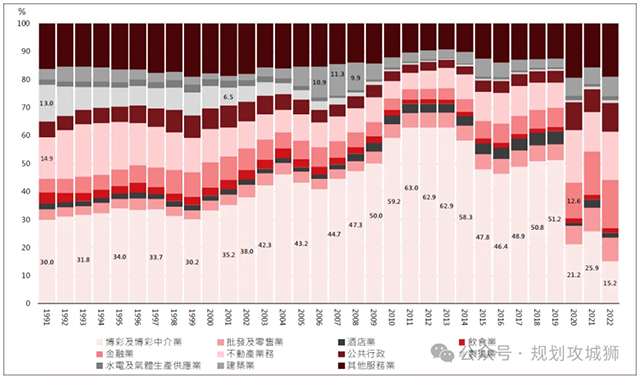
Comparison Chart of Value Added by Industry Calculated at Producer Prices Using the Production Method from 1991 to 2022 (Xingzoujiaotong/Guihuagongchengshi)
3.Macau: A World Center of Tourism and Leisure.
Macau is one of the world's most concentrated cities for cultural heritage. Despite its modest size of just 33.3 square kilometers, it boasts over 170 diverse attractions. In Macau, historical charm seamlessly blends with modern allure, making it a prime destination for travelers.
In 2023, Macau welcomed 28.21 million inbound visitors—41 times its population. Among them, 14.23 million were overnight visitors, and 13.99 million were same-day visitors, representing year-on-year increases of 4.7 times and 3.3 times, respectively.
Of the 28 million visitors, mainland Chinese tourists accounted for 19.05 million, comprising 67.5% of all arrivals. Notably, 9.31 million visitors came from the nine cities of the Greater Bay Area’s Pearl River Delta, marking a 1.8-fold increase. Additionally, visitors from Hong Kong and international markets reached 7.2 million and 1.46 million, accounting for 25.5% and 5.2% of total arrivals, with year-on-year increases of 13-fold and 105.9%, respectively.
These figures underscore Macau's status as a world-class hub for tourism and leisure, where rich cultural heritage meets dynamic growth in visitor engagement.
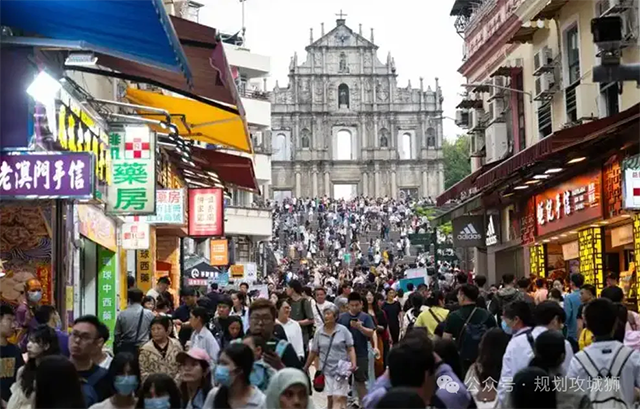
Tourists in Macau (Xingzoujiaotong/Guihuagongchengshi)
4.A Transit Model Dominated by Buses, with Equal Emphasis on Motorcycles and Private Cars
Macau's motorized transportation consists of light rail, buses, motorcycles, private cars, and taxis. According to the 2019 resident travel survey, the average daily motorized trips per person in Macau reached 1.28. Buses accounted for 40.6% of trips, while motorcycles and private cars represented 21.8% and 27.4%, respectively, with taxis contributing 6.9%.
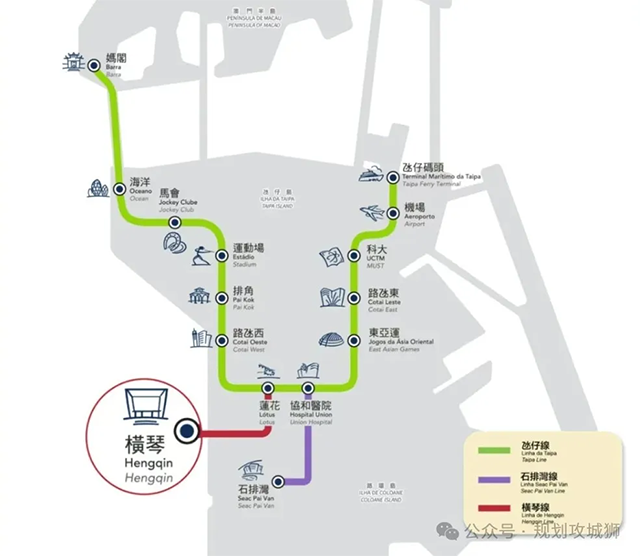
Macau Light Rail Network Layout Map(Xingzoujiaotong/Guihuagongchengshi)
Light Rail Development
Macau began planning its rail transit system in 2007, adopting a medium-capacity light rail model. The trains consist of two-car configurations, operating in single or double sets. Since the launch of the Taipa Line in 2019, Macau has opened three light rail lines with a total length of approximately 16.3 kilometers. These lines connect key areas, including inter-island transportation hubs, the Hengqin Port, and the University of Macau. Future expansions aim to transition the system from single lines to a comprehensive network.
Public Bus System
Given the limited coverage of the light rail, buses and taxis remain the primary modes of public transportation. In 2023, two bus companies—Macau New Era Public Bus Company and Transportes Urbanos de Macau—operated 88 routes with 1,091 vehicles. Daily bus ridership averaged 615,500, nearly returning to pre-pandemic levels, with record-breaking figures exceeding 803,000 during the National Day holiday.
To enhance service quality, Macau's transportation authorities implemented several initiatives, such as real-time road condition apps, bus information systems, passenger load estimation tools, and parking availability updates. The bus passenger load estimation system, for example, provides real-time occupancy rates to help commuters plan their journeys while enabling bus companies to optimize resource allocation.

Bus Passenger Load Estimation System (Xingzoujiaotong/Guihuagongchengshi)
Motorcycles in Macau
Macau also has a strikingly high number of motorcycles, totaling 128,000 in 2023—an impressive figure given the city's limited land area. This includes light motorcycles, heavy motorcycles, and electric motorcycles.
However, this prevalence has led to two significant issues:
lReckless Driving: Many riders engage in risky maneuvers, weaving through narrow roads and congested traffic, increasing accidents and intensifying traffic congestion.
lParking Chaos: The limited parking space has resulted in widespread disorderly parking, further complicating traffic flow.
Efforts to address these challenges are critical to improving Macau's overall transportation environment, balancing its high-density urban setting with efficient and safe mobility options.
5.A Model of the "Narrow Roads and Dense Networks" Planning Concept
As a crucial gateway in the Pearl River Delta, Macau’s distinctive road network embodies over 400 years of Chinese and Portuguese historical, cultural, and traditional integration.
Unique Urban Fabric
Macau's urban structure combines a medieval Western city framework with traditional Chinese “Li-Fang” concepts, reflecting a fusion of Portuguese and Chinese urban planning principles. Scholar Wang Weiren describes Macau's labyrinth-like urban fabric as composed of a hierarchical street system, including “avenues, roads, streets, alleys, and enclosures,” with "enclosures" playing a key role in defining the city’s texture.
In this system:
lAvenues and Roads facilitate regional connections.
lStreets and Roads manage traffic flow within main thoroughfares.
lAlleys, Enclosures, and Courtyards serve local, community-scale interactions.
These elements together form a binary cultural context, integrating traditional Chinese and Portuguese influences into Macau's urban landscape.
Dense Road Network
Macau boasts a highly dense road network with an average density of 10.3 km/km2. On the Macau Peninsula, the density rises to 20.4 km/km2, reaching up to 25 km/km2 in older districts like St. Lazarus Parish and around 23 km/km2 in newer districts such as Areia Preta.
Compact Roads
Due to limited land availability, Macau's roads are notably narrow:
lOverall average width: 13.6 m, with most being two-way, four-lane or smaller roads.
lMacau Peninsula: Average road width of 10.1 m, with 77% of roads being two-way, one- to three-lane routes.
lWidth variations: Avenues and roads range from 11–32 m, streets 3–10 m, and alleys and enclosures 3–4.5 m.
Efficient Design
Macau employs meticulous design strategies to maximize space usage:
lMotorway lanes are typically 3.20–3.25 m wide, with some constrained segments as narrow as 2.7 m.
lIntersection turning radii are minimized, with the smallest radius between 5–6 m.
This "narrow roads and dense networks" approach exemplifies how Macau balances limited space with functional and efficient urban transportation, creating a road system that integrates heritage and modern urban needs.
6.Macau's First Five-Year Plan: "Macau Five-Year Development Plan (2016-2020)"
In 2015, Macau initiated its first-ever five-year development plan, aiming to align with the national overarching planning and positioning of Macau’s development, and set concrete goals for the city's growth. This plan marked a significant step in the economic governance model of Macau, moving beyond the limitations of a free-market economic system.
With a forward-looking, long-term, and systematic strategic approach, the plan outlined key directions, priority sectors, and specific goals for Macau's economic development. It provided a pragmatic and effective guide to steer the city’s economy toward healthy and orderly growth.
Macau implemented two five-year plans: the 2016-2020 plan, which aligned with China's 13th Five-Year Plan, and the 2021-2025 plan, which aligns with China's 14th Five-Year Plan. These plans reflect Macau’s commitment to planning for sustainable economic growth, contributing to both its local development and broader national goals.
7.Macau's Urban Master Plan: "Macau Special Administrative Region Urban Master Plan (2020-2040)"
In 2020, the Macau SAR Government launched a public consultation for the Macau Special Administrative Region Urban Master Plan (2020-2040). The plan outlines Macau’s future urban positioning, including:
lNational Positioning: A world center for tourism and leisure, and a service platform for trade and cooperation between China and Portuguese-speaking countries.
lRegional Positioning: A base for cultural exchange and cooperation, with Chinese culture as the main influence and a diverse cultural mix; a central city in the Guangdong-Hong Kong-Macau Greater Bay Area; an important support point in the Greater Bay Area's technological innovation corridor; and one of the three key hubs in the Greater Bay Area.
lLocal Positioning: A beautiful home for the people of Macau.
The vision of the plan is to transform Macau into a joyful, intelligent, sustainable, and resilient city, reflecting a holistic approach to its urban development over the next two decades.
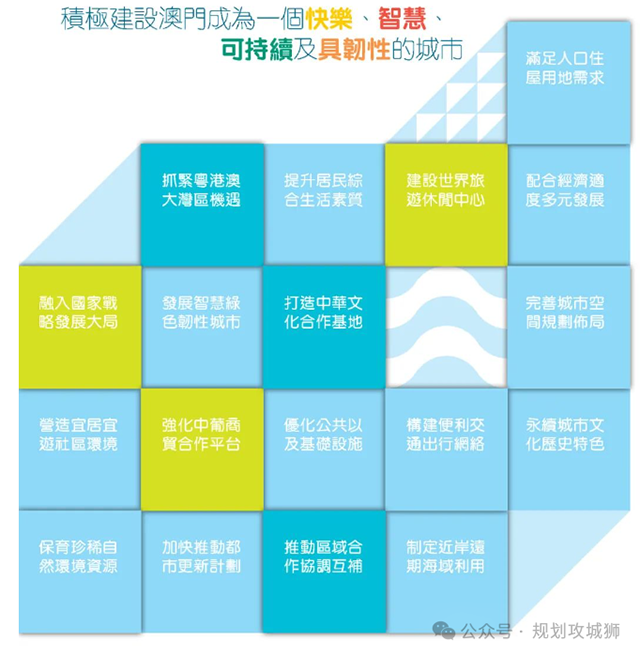
Macau's overall urban planning vision: To become a happy, smart, sustainable, and resilient city.(Xingzoujiaotong/Guihuagongchengshi)
8.Macau's Industrial Plan: "Macau Special Administrative Region Economic Moderate Diversification Development Plan (2024-2028)"
The plan clearly outlines Macau's overall goal for moderate economic diversification, aiming to leverage Macau's unique advantages and capitalize on national development opportunities. The development positioning centers around "One Center, One Platform, One Base", and follows the development directions outlined in the Special Administrative Region's “14th Five-Year Plan”.
The strategy for achieving this includes effectively implementing the "1+4" economic diversification model, which focuses on:
lOptimizing and strengthening the integrated tourism and leisure industry.
lAccelerating the development of the Traditional Chinese Medicine (TCM) health industry, modern finance, high-tech industries, and the convention, exhibition, commerce, and cultural sports sectors.
9.Macau Transportation Plan: "Macau Road Traffic Transport Ten-Year Plan (2021-2030)"
As a small and densely built city, Macau faces significant spatial and land resource constraints, leading to a transportation planning model that can be described as “operating within a small shell.” This contrasts sharply with many mainland Chinese cities, where urban construction areas continue to expand (e.g., new districts and cities), and transportation planning increasingly extends beyond built-up areas.
From May 24 to July 22, 2022, the Macau SAR government held a public consultation for the Macau Road Traffic Transport Plan (2021-2030) (hereafter referred to as the "Transport Plan"). The Transport Plan focuses on two core policies: "Public Transport Priority" and "Vehicle Control". Its goal is to enhance, optimize, and rebalance the road transportation system, aiming to provide a safer, greener, more efficient, convenient, and pedestrian-friendly transportation environment for both residents and visitors. Ultimately, the plan aims to create a sustainable road transportation system.
Key Strategies of the "Transport Plan":
lImplementing "Two Key Networks": The construction of three interconnected networks — road networks, rail networks, and pedestrian networks — to create a seamless transport system.
l"Three Areas of Focus": The plan emphasizes efforts in planning and construction, operation and management, and policy and regulations.
lMeasures for Comprehensive Improvement: The plan includes strategies for effective construction, enhancing quality and efficiency, scientific demand control, and smart development to significantly improve the traffic conditions and services in Macau.
This comprehensive plan seeks to optimize urban mobility while addressing the challenges posed by limited space, ensuring a more sustainable and effective transportation framework for the city.
10.The Macau Model of Urban Renewal and City Restoration
As a city with a long history, Macau faces numerous challenges in its old districts as urban development progresses. Urban renewal and the renovation of historic areas have become essential elements in the city's development.
In the field of urban renewal, Macau's approach is influenced by various laws and policies, including the Basic Law of Macau, Urban Planning Law, Land Law, Macau Historic City Protection and Management Plan, and Macau Urban Renewal Legal System. These legal frameworks impose higher and more complex requirements on urban renewal projects.
In 2016, the Macau SAR government established the Urban Renewal Advisory Committee to assist in the formulation of urban renewal policies. In 2019, the government set up Urban Renewal Limited Company as a private entity to promote and coordinate local urban renewal efforts. In January 2023, the Macau Urban Renewal Legal System came into effect, marking the official entry of urban renewal in Macau into a legalized phase.
On September 10, 2024, M8 Macau No. 8, the first commercial urban renewal project since Macau's return to China, opened in the core of Macau's historic district. The M8 building was originally the staff dormitory of the Macau Post and Telecommunications Bureau and is located just 50 meters from the Senado Square. It represents another significant achievement in the revitalization of Macau's old districts.
The name M8 symbolizes both Macau and the 8% of land in the city’s historic center. The area is surrounded by eight UNESCO World Heritage sites, including the City Hall, Santa Casa da Misericórdia, St. Paul’s Cathedral, Largo do Senado, Lu’s Mansion, Rose Chapel, and Basilica of St. Lawrence, encapsulating Macau's historical essence.
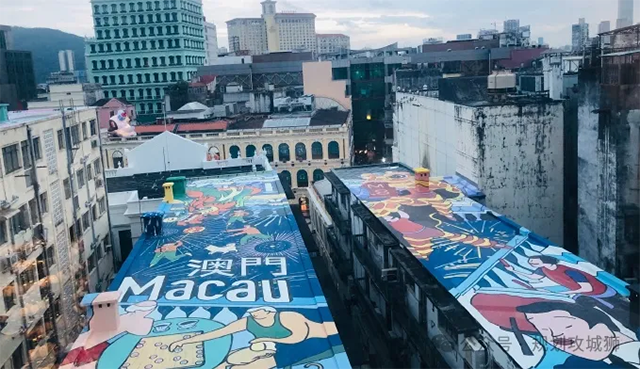
The M8 commercial urban renewal project in Macau, in the historic city center of Macau. (Xingzoujiaotong/Guihuagongchengshi)
In the restoration and reconstruction process, the project follows the principles of respecting historical context and preserving the urban fabric. It adopts a design approach that blends Chinese and Portuguese influences, integrating old and new elements, and combines dynamic and static aspects. The restoration innovatively explores new paths for urban renewal, aiming to harmonize the renovated buildings with their surrounding neighborhoods, communities, and streets. The goal is to create structures that “grow” within the existing natural environment and cultural atmosphere, ensuring the continuity and elevation of cultural heritage.
Edited by Jingyuan Zhang with reference to https://mp.weixin.qq.com/s/W1_edJ9n6oAvDGM68XrZfg